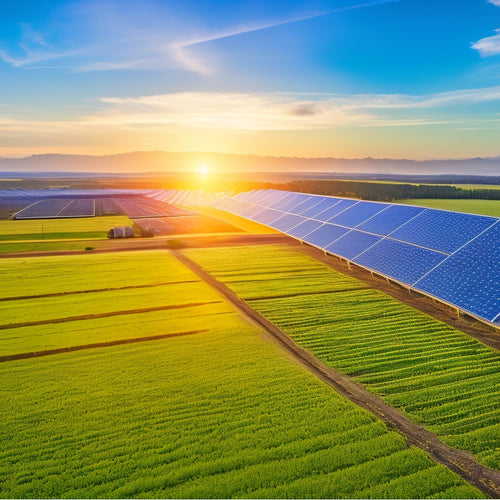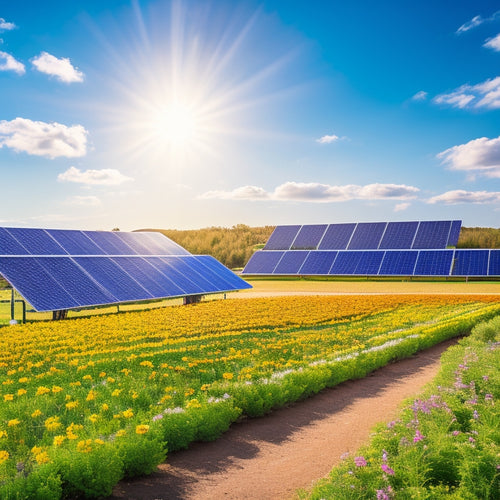
Sizing Right: Panels for Business Roof Spaces
Share
When installing solar panels on your business's roof, getting the system size right is essential. You'll need to determine your energy needs through an energy audit, assess roof space constraints like clearance and structural integrity, and choose the right panel type for your business. Calculate peak sun hours to optimize panel placement, and consider factors like energy usage patterns, roof size, and orientation. By doing so, you'll be able to maximize energy efficiency, reduce energy costs, and minimize your carbon footprint. As you consider these key factors, you'll be well on your way to harnessing the full potential of your business's roof space.
Key Takeaways
• Conduct an energy audit to determine energy requirements and identify areas of inefficiency for optimal solar panel system sizing.
• Assess roof space constraints, including clearance, obstructions, and structural integrity, to ensure proper panel placement and weight support.
• Evaluate panel type and quality, considering factors like aesthetic appeal, environmental impact, and maintenance, to optimize energy production and efficiency.
• Calculate peak sun hours and solar irradiance data to determine the ideal system size and maximize energy production for the commercial roof space.
• Ensure scalability and future-proofing of the solar panel system to accommodate changing energy needs and minimize downtime and resource waste.
Understanding Your Energy Needs
To optimize energy efficiency in your business roof space, you must first determine your energy requirements. This involves calculating your total energy load and identifying areas of inefficiency. This process begins with an energy audit, a thorough examination of your energy usage patterns.
You'll need to gather data on your energy consumption, including peak usage times and equipment specifications. Next, perform load calculations to determine your total energy load, taking into account factors like lighting, HVAC, and equipment usage. By identifying areas of inefficiency, you can pinpoint opportunities for improvement and optimize your energy usage.
Accurate load calculations are essential, as they'll inform your decision-making when selecting and sizing solar panels for your roof space.
Assessing Roof Space Constraints
As you prepare to install panels on your business's roof space, it's crucial to evaluate the constraints that might impact your project.
You'll need to assess roof clearance, making sure there's enough space between the panels and any obstructions, such as vents or skylights.
Additionally, you'll need to examine potential obstructions and check the structural integrity of your roof to confirm it can support the weight of the panels.
Roof Clearance Considerations
When evaluating roof space constraints, you must consider the minimum clearance requirements for your panels to guarantee safe and efficient installation, maintenance, and operation.
You'll need to confirm there's enough room for ventilation paths to facilitate airflow and prevent moisture buildup.
Additionally, you'll need to factor in the snow load impact, which can affect the structural integrity of your roof.
Failure to account for these factors can lead to compromised performance, safety hazards, and even system failure.
Obstruction Analysis Required
You'll need to conduct a thorough obstruction analysis to identify and map out any obstacles that could impede the installation, maintenance, or operation of your panels in the roof space. This analysis is essential to guarantee a smooth and efficient installation process.
Some key considerations for your obstruction analysis include:
-
Object detection: Identify any obstacles such as vents, skylights, or existing HVAC equipment that could interfere with panel placement.
-
Shadow analysis: Analyze the roof's layout to determine potential shading issues that could affect panel performance.
-
Structural components: Take note of any roof beams, trusses, or other structural elements that could impact panel installation or maintenance.
- Roof penetrations: Identify any existing penetrations, such as pipes or ductwork, that could affect panel placement or require additional installation considerations.
Structural Integrity Checks
Your roof's structural integrity must be carefully evaluated to confirm it can support the added weight of the panels and withstand various environmental conditions. You'll need to assess the roof's existing load-carrying capacity and perform load calculations to determine if it can handle the additional weight.
Building codes and local regulations must also be considered to guarantee compliance. This involves reviewing the roof's design, materials, and construction to identify potential weaknesses or vulnerabilities. A thorough structural integrity check will give you a clear understanding of your roof's capabilities, allowing you to make informed decisions about panel installation and secure a safe and successful project.
Choosing the Right Panel Type
When selecting the right panel type for your business roof space, you'll need to evaluate the materials that make up the panel.
You'll want to compare the benefits of metal panels versus those with a membrane, and think about the insulation performance you need to achieve.
Panel Materials Matter
Selecting the right panel type for your business roof space depends on the specific properties and benefits of various materials. This includes factors like durability, insulation, and cost-effectiveness. You need to take into account factors that align with your business goals and priorities.
Some key considerations include:
-
Aesthetic appeal: Will the panels complement your building's design and architecture?
-
Environmental impact: Do the materials align with your company's sustainability goals?
-
Moisture resistance: Can the panels withstand harsh weather conditions?
- Maintenance requirements: How often will the panels need to be inspected and maintained?
Metal Vs. Membrane
Two primary panel types, metal and membrane, dominate the market, each offering distinct advantages that must be carefully considered to guarantee the best choice for your business roof space.
When deciding between metal and membrane panels, you'll want to conduct a cost comparison. Metal panels tend to be more expensive upfront, but they're durable and require minimal maintenance.
Membrane panels, on the other hand, are often more budget-friendly, but they may need to be replaced more frequently. Installation challenges also come into play.
Metal panels can be heavier and more difficult to install, while membrane panels are generally lighter and easier to handle.
Insulation Performance Counts
You need to prioritize insulation performance when choosing the right panel type for your business roof space, as it directly impacts energy efficiency and your bottom line. Insulation performance is critical to maintaining a consistent indoor climate, reducing energy costs, and minimizing environmental impact.
When selecting a panel type, consider the following factors to optimize insulation performance:
-
R Value Optimization: Guarantee the panel's R-value meets your building's specific climate and energy efficiency requirements.
-
Thermal Bridging: Minimize thermal bridging by choosing panels with continuous insulation and secure fastening systems.
-
Moisture Management: Select panels with built-in moisture management systems to prevent water infiltration and damage.
- Air Tightness: Opt for panels with advanced air-tightness features to prevent air leaks and heat loss.
Calculating Peak Sun Hours
To accurately calculate peak sun hours, first determine your business's location-specific solar irradiance data, as this will greatly impact the effectiveness of your rooftop solar panel installation. You can obtain this data from sources like NASA's Surface Meteorology and Solar Energy dataset or the National Renewable Energy Laboratory's (NREL) PVWatts Calculator.
| Climate Zone | Solar Irradiance (kWh/m²/day) | Peak Sun Hours (PSH) |
|---|---|---|
| Tropical | 5.5-6.5 | 5-6 |
| Desert | 6.5-7.5 | 6-7 |
| Temperate | 4.5-5.5 | 4-5 |
| Polar | 2.5-3.5 | 2-3 |
Understanding climate variations and their impact on solar irradiance will help you optimize your solar panel installation for maximum energy output.
Sizing for Energy Efficiency
Properly sizing your solar panel installation is crucial for maximizing energy efficiency. An undersized system can lead to reduced energy output and a longer payback period. To get it right, you'll need to conduct an energy audit to assess your business's energy needs and identify areas for improvement. This will help you determine the ideal system size for your roof space.
Consider the following factors to make sure your system is sized for energy efficiency:
- Your business's energy usage patterns and peak demand
- The size and orientation of your roof space
- The efficiency and quality of your solar panels
- Your goals for reducing your carbon footprint and energy costs
Considering System Expandability
As your business grows and energy demands evolve, a scalable solar panel system guarantees you can easily add more panels or upgrade existing infrastructure to meet increasing energy needs. This future-proofing approach assures your system adapts seamlessly to changing energy requirements, saving you time and resources in the long run.
A well-designed scalable system allows you to add new components or upgrade existing ones without disrupting your entire infrastructure. This flexibility is vital in minimizing downtime and maximizing energy production.
Maximizing Roof Space Potential
Optimize your business's roof space by carefully evaluating its dimensions, structural integrity, and any obstacles to guarantee a solar panel system that maximizes energy production while minimizing installation costs.
To guarantee a seamless installation, consider the following factors:
-
Roof aesthetics: Confirm the solar panel system blends with your building's architecture to maintain a professional appearance.
-
Space optimization: Strategically place panels to maximize energy production while avoiding obstacles like skylights, vents, or roof drains.
-
Structural integrity: Assess your roof's load capacity to verify it can support the weight of the solar panels.
- Shading analysis: Identify potential shading issues from surrounding structures or trees to optimize panel placement.
Frequently Asked Questions
Can I Install Solar Panels on a Roof With Multiple Skylights?
As you gaze up at your roof, you're wondering if solar panels can coexist with multiple skylights; fortunately, you can install them, but be prepared to navigate skylight obstruction and consider roof reinforcement to guarantee a secure fit.
How Do I Ensure Snow Load Capacity for My Solar Panel System?
To guarantee snow load capacity for your solar panel system, you'll need to conduct a structural analysis and perform load calculations to determine the maximum weight your roof can handle, then select panels that meet those specifications.
Are There Any Local Building Codes I Need to Comply With?
You'd be crazy to overlook local building codes! Research zoning regulations and code exemptions to guarantee compliance, avoiding costly rework or even system removal - don't risk your investment, stay code-compliant from the start.
Can I Add a Battery Backup to My Solar Panel System?
You can add a battery backup to your solar panel system, achieving energy storage and grid independence, ensuring uninterrupted power supply during outages, and optimizing your energy usage.
What Kind of Maintenance Is Required for My Solar Panel System?
You'll be thrilled to know that maintaining your solar panel system is a breeze! You'll need to clean your panels regularly, ensuring maximum energy harnessing, and monitor energy production to detect any issues, giving you total control over your system's performance.
Related Posts
-

Solar Power for Reducing Carbon Footprint
Solar power is an effective strategy for reducing your carbon footprint. By adopting solar energy, you can cut greenh...
-

Solar Inverter Troubleshooting for Beginners
Troubleshooting your solar inverter starts with understanding its efficiency and performance metrics. Check for prope...
-

High-Performance Solar Solutions for Sustainable Living
High-performance solar solutions are your gateway to sustainable living, maximizing energy efficiency while considera...


